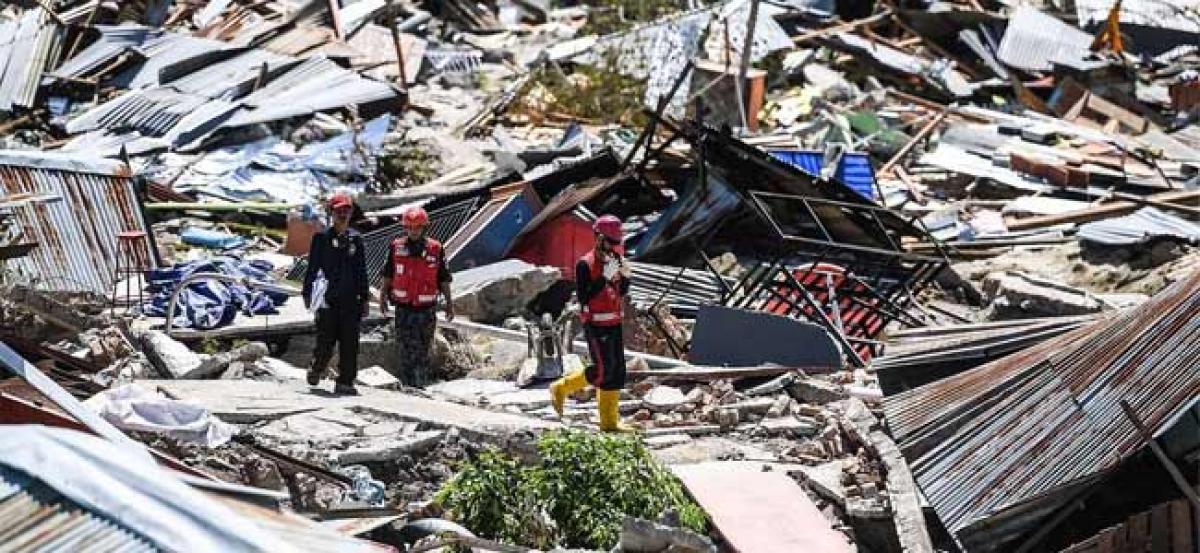No siren, no warning: Indonesians caught unawares by devastating tsunami

When up to sixmetre 20foot tsunami waves crashed into the Indonesian city of Palu last month, Didiek Wahyudi Kurniawans house near the beach was quickly engulfed with water, leaving his wife and two daughters barely any time to escape
When up to six-metre (20-foot) tsunami waves crashed into the Indonesian city of Palu last month, Didiek Wahyudi Kurniawan's house near the beach was quickly engulfed with water, leaving his wife and two daughters barely any time to escape.
"I know there is supposed to be a tsunami warning alarm, but maybe it was outdated? I have no idea. We never get any warning from it," said Kurniawan, 46.
He said he was out at the time but his family escaped by wading through chest-high water to a neighbour's three-storey building.
While his family was spared, scores attending a beach festival in Palu were among those swept away, adding to the more than 1,600 deaths from the 7.5 magnitude quake and tsunami that have been confirmed so far.
Other survivors also said they heard no sirens, even though a tsunami warning was issued and then lifted 34 minutes after the quake, based on data available from the closest tidal sensor, around 200 km (125 miles) from Palu, which is on Sulawesi island.
As Indonesia struggles with the aftermath of the devastating quake, the spotlight has again been shone on the apparent lack of preparedeness in a sprawling archipelago that suffers regular tremors, lying on the seismically active so-called Pacific Ring of Fire.
There was a major push in the region to improve warning systems after the 2004 Indian Ocean tsunami killed more than 120,000 in Indonesia alone, including establishing a network of 22 warning buoys to detect tsunamis that was put in place with German and US help. International agencies and countries poured $4.6 billion into the reconstruction of Indonesia's devastated Aceh province on Sumatra island, with new infrastructure such as strategically placed evacuation centres.
Still, with the first waves in Palu arriving within around four minutes and power and communications knocked out by the quake, text message alerts or sirens would probably not have been enough, even if they were working.
Denis McClean, a spokesman of the UN Disaster Risk Reduction agency, told a briefing only public awareness would have saved people under these circumstances.
"It happened very quickly. There wasn't much time for warnings to be disseminated, so it was very much dependent on the level of public awareness in order to save lives."
"THE EARTHQUAKE IS THE WARNING"
Indonesia's national disaster mitigation agency spokesman Sutopo Purwo Nugroho said people still often did not know what to do when a disaster strikes.
Unlike in quake-prone countries like Japan and New Zealand, earthquake education and drills are conducted only sporadically in Indonesia.
"The problem in tsunami early warning systems is not the structure, not its tools, but the culture in our communities," Nugroho told reporters.
Palu has some tsunami evacuation route signs, but Mokhtar, a resident, said while he was aware of government sponsored simulations shown on television on what to do in an earthquake, he had not seen any on the ground.
"There is a warning system but on that day there was none. No siren or anything," said the 51-year-old civil servant, adding that he has never heard the warning system ever.
Nugroho of the diaster agency said communities sometimes vandalise early warning tools like tsunami buoys.
The network of 22 buoys in Indonesia, which are connected to seabed sensors, have been inoperable since 2012, often due to neglect or vandalism.
Fishermen often used buoys to tie their boats, sometimes damaging sensors, while in one case a buoy was towed by fishermen from its original mooring to another part of the sea off Sulawesi. Indonesian President Joko Widodo called this week for the buoys to be repaired or replaced, but experts and officials say investment has also been neglected in other areas.
According to data from the disaster agency, out of about 1,000 tsunami sirens needed across Indonesia, only 56 are in place.
Only about 3,100 km (1,920 miles) of evacuation routes have been established against a need for 11,900 km (7,390 miles), while there are only 50 evacuation shelters compared with estimates of 2,200 needed, the data showed.
The speaker of Indonesia's parliament, Bambang Soesatyo, pledged in a statement that at least in the case of buoys, parliament would support the budget for this.
Adam Switzer, a tsunami expert at the Earth Observatory of Singapore, said from evidence so far it appeared the tsunami in Palu was generated by a submarine landslide, something most warning systems would not pick up.
"The earthquake is the warning. The first thing you need to do is take cover in a safe space until the shaking stops and then get yourself away from the coast. It's about education," said Switzer, stressing that this needed "to be ingrained in every child in Asia, especially in Southeast Asia".
Even putting aside the human cost, there are powerful economic arguments for doing more to prepare for disasters.
Udrekh, a disaster expert at Indonesia's Agency for the Assessment and Application of Technology (BPPT), said Indonesia is discussing with Japan whether to invest in seabed cables with sensors that could detect tsunami and earthquakes, similar to a system in Japan. Such cables would be less vulnerable and quicker than buoys and cost 300 billion rupiah ($19.8 million) a year for every 200 km (125 miles), he said.
"We always say for disaster infrastructure that you save $7 for every $1 investment you make, so this is needed and the cost is nothing compared to other infrastructure," he said.
He estimated Indonesia lost about 30 trillion rupiah ($2 billion) each year from disasters, but spent too little on disaster mitigation infrastructure and education.
"It's like we never learned from 2004," he told Reuters.








